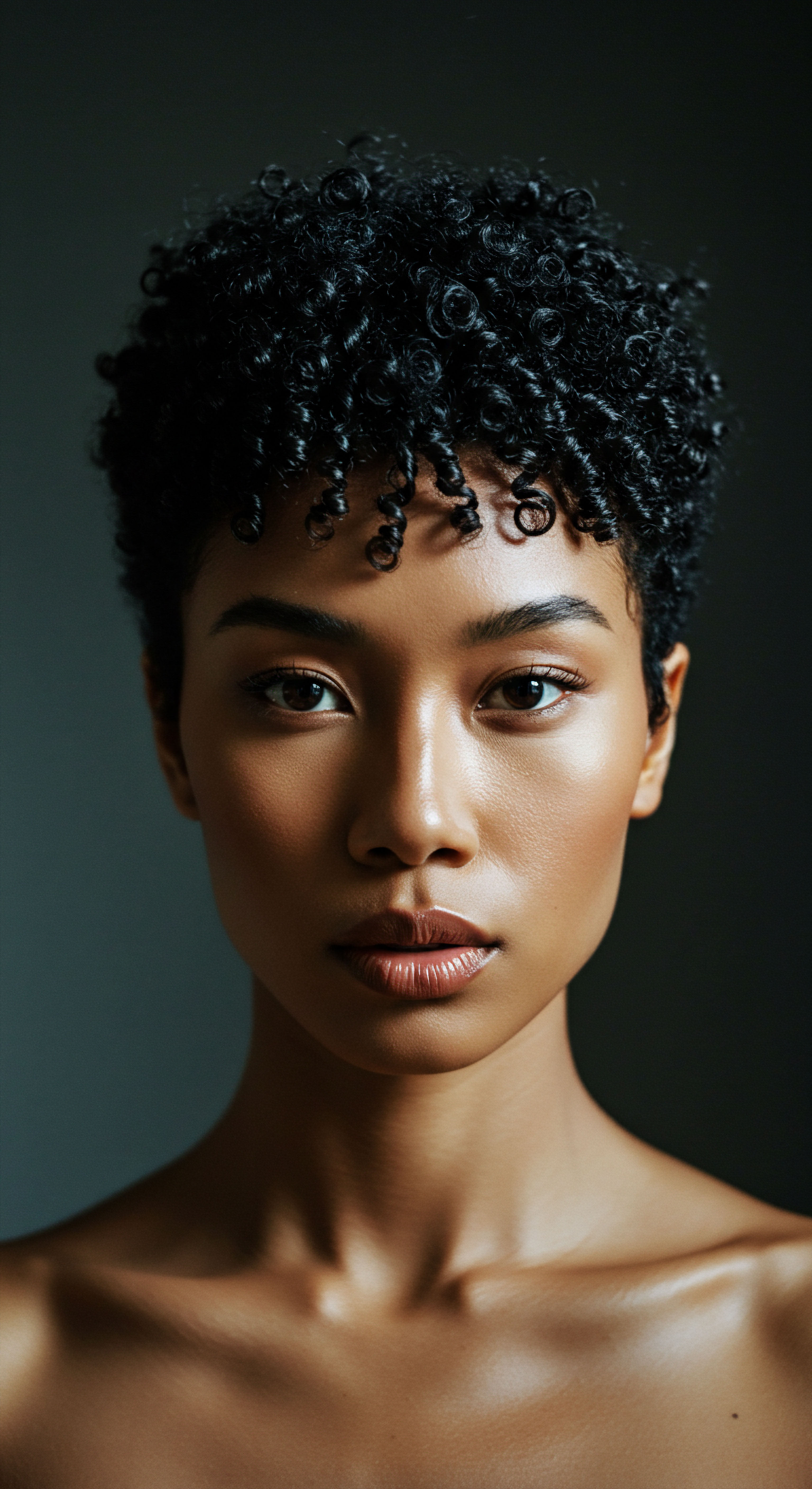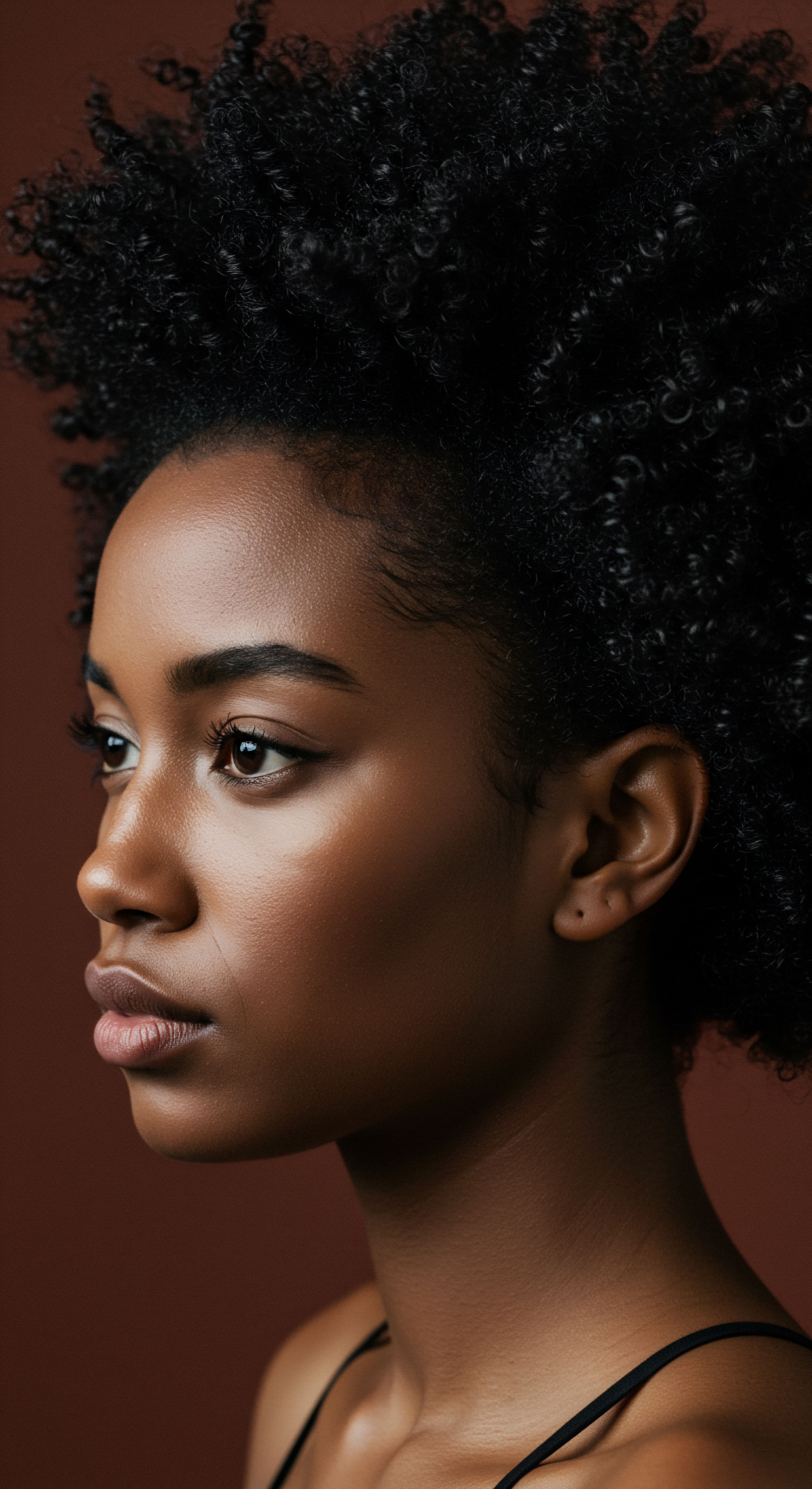
Roots
The quiet moments of rest, often overlooked in the bustling rhythm of daily life, hold a profound, often unseen, influence on the delicate biology that shapes our strands. For those with textured hair, a heritage rich in diverse curl patterns and coil formations, understanding these foundational connections extends beyond mere aesthetics. It reaches into the very core of cellular renewal and the cyclical dance of growth and repose that dictates hair’s vitality. We often consider external factors—products, styling methods, environmental conditions—as primary shapers of our hair’s journey.
Yet, beneath the surface, within the very follicles that cradle each strand, a silent, internal orchestration plays out, deeply attuned to the body’s natural rhythms. Can the consistent cadence of our sleep patterns truly sway the intricate growth cycles of textured hair? This inquiry leads us to the fundamental processes that govern our hair’s existence, from its microscopic origins to its outward display.
The body’s internal clock, often reset by consistent sleep, significantly influences the silent, microscopic processes that govern hair’s vitality and growth.

Hair Anatomy and Physiology Specific to Textured Hair
Textured hair, a term encompassing a spectrum of curl types from waves to tight coils, possesses a unique anatomical blueprint that sets it apart. The elliptical or flat shape of the hair follicle itself, rather than the perfectly round follicle of straight hair, contributes to the characteristic curl. This unique shape causes the hair shaft to grow in a helical, or spiral, fashion.
The distribution of keratin proteins within the hair shaft also varies; textured hair often exhibits an uneven distribution, which can contribute to points of weakness and susceptibility to breakage. The outer layer, the Cuticle, composed of overlapping scales, tends to be more raised in textured hair, leading to a greater propensity for moisture loss and, conversely, a higher surface area for product absorption.
Beneath the cuticle lies the Cortex, the hair’s primary structural component, responsible for its strength and elasticity. Within the cortex, macrofibrils and microfibrils of keratin are arranged in a specific manner, influenced by the follicle’s shape. The innermost layer, the Medulla, is often discontinuous or absent in fine hair but can be more prominent in coarse, textured strands.
The health of these layers, particularly the cuticle’s integrity and the cortex’s robust structure, directly impacts the hair’s ability to retain moisture, resist damage, and ultimately, grow long and strong. Any disruption to the cellular machinery supporting these structures can echo through the entire hair fiber.

Hair Growth Cycles and Influencing Factors
Hair growth follows a cyclical pattern, a biological rhythm that repeats throughout our lives. This cycle has three main phases ❉
- Anagen ❉ The active growth phase. During this period, hair cells divide rapidly, pushing the hair shaft upwards. This phase can last from two to seven years, and its duration largely determines the maximum length a hair can attain. For textured hair, which can appear shorter due to shrinkage, a longer anagen phase is especially important for achieving noticeable length.
- Catagen ❉ A transitional phase. This short period, lasting only a few weeks, signals the end of active growth. The hair follicle shrinks, and the hair detaches from the blood supply.
- Telogen ❉ The resting phase. The hair remains in the follicle, but no active growth occurs. This phase typically lasts for about three months. At the end of telogen, the old hair sheds, and a new anagen hair begins to grow from the same follicle, restarting the cycle.
A small percentage of hairs are always in the catagen or telogen phase, accounting for normal daily shedding. However, a significant shift in the proportion of hairs entering the telogen phase prematurely can lead to noticeable thinning or shedding. This phenomenon, known as Telogen Effluvium, often arises from systemic stressors that disrupt the body’s normal functions, including profound shifts in sleep patterns.
Several factors can influence these cycles. Genetics play a significant role, dictating the potential length of the anagen phase. Hormonal fluctuations, nutritional deficiencies, certain medications, and systemic illnesses can all impact the hair growth cycle. Stress, both physical and emotional, is a well-documented disruptor, often prematurely pushing hairs into the resting phase.
The body’s internal clock, the Circadian Rhythm, orchestrates many physiological processes, including cell division and hormone secretion, which are intimately tied to hair follicle activity. A regular, restorative sleep schedule helps maintain this rhythm, providing the optimal environment for healthy hair growth.

Ritual
Moving beyond the fundamental biological underpinnings, we turn our attention to the practical wisdom that emerges from understanding hair’s deeper needs. For those with textured hair, the daily and nightly practices we adopt are not merely routines; they are rituals, quiet acts of care that profoundly influence the hair’s well-being. How do these deliberate actions, particularly those surrounding our sleep, align with the hair’s innate cycles?
This section explores the tangible connections between consistent sleep patterns and the flourishing of textured hair, examining how the quiet hours of night become a crucial period for restoration and growth. It’s a conversation about aligning our conscious choices with the hair’s unconscious rhythms, seeking harmony between external care and internal biological processes.
Nighttime care, a deliberate ritual of protection and replenishment, becomes a cornerstone for supporting textured hair’s natural growth rhythms.

The Nighttime Sanctuary Essential Sleep Protection
The hours spent in slumber are not merely a pause in our day; they represent a critical period of repair and regeneration for the entire body, including our hair. During sleep, the body diverts energy towards cellular restoration, hormone regulation, and tissue repair. For textured hair, which is inherently more prone to dryness and mechanical damage, nighttime protection is not simply a suggestion; it is a vital component of any care regimen.
Sleeping directly on cotton pillowcases can draw moisture from the hair, leading to dryness, friction, and ultimately, breakage. The rough texture of cotton can also snag delicate strands, disrupting curl patterns and causing frizz.
This is where the wisdom of sleep protection becomes apparent. Tools like silk or satin pillowcases and bonnets serve as guardians against these nocturnal threats. Their smooth surfaces minimize friction, allowing hair to glide freely, preserving moisture and preventing tangles.
This reduction in mechanical stress helps to maintain the integrity of the cuticle, reducing breakage and enabling the hair to progress through its growth cycle unimpeded. A consistent practice of protecting hair at night reduces the need for aggressive detangling in the morning, further minimizing stress on the strands.

Bonnet Wisdom and Its Practical Benefits
The humble bonnet, a staple in many textured hair care routines, embodies centuries of practical wisdom regarding hair preservation. Beyond its protective qualities against friction and moisture loss, a bonnet helps to maintain curl definition, extending the life of washes and styles. This means less manipulation, less heat styling, and ultimately, less stress on the hair.
The benefits extend to the scalp environment as well. A protected scalp is less exposed to environmental aggressors during sleep, allowing its delicate microbiome to remain balanced. A healthy scalp is, after all, the foundation for healthy hair growth. The consistent use of a bonnet, therefore, is not just about preserving a hairstyle; it contributes to a holistic approach to hair health that aligns with the hair’s natural regenerative processes that occur during rest.
| Protective Measure Silk/Satin Pillowcase |
| Key Benefit Reduces friction and moisture absorption. |
| Impact on Hair Growth Minimizes breakage, preserving hair length. |
| Protective Measure Silk/Satin Bonnet |
| Key Benefit Encapsulates hair, protects from friction, retains moisture. |
| Impact on Hair Growth Significantly reduces breakage, maintains curl integrity, supports length retention. |
| Protective Measure Pineapple Method |
| Key Benefit Gathers hair loosely at the crown. |
| Impact on Hair Growth Prevents flattening of curls, reduces tangles. |
| Protective Measure Consistent nighttime protection safeguards textured hair, aiding its journey through growth cycles. |

Can Disruptions in Sleep Lead to Hair Loss?
The connection between sleep and hair vitality runs deeper than surface-level protection. Chronic sleep deprivation or irregular sleep patterns can trigger a stress response within the body. When the body perceives stress, it releases hormones like Cortisol. While short-term cortisol spikes are normal, sustained elevated levels can disrupt various physiological processes, including the hair growth cycle.
Research indicates that stress hormones can prematurely push hair follicles from the active growth (anagen) phase into the resting (telogen) phase. This can result in increased shedding, often noticed several months after the initial stressor.
The body’s natural repair mechanisms are most active during deep sleep. Disrupted sleep limits the time available for these processes. Cellular regeneration, protein synthesis, and hormone regulation—all vital for healthy hair follicle function—are compromised. A lack of consistent, restorative sleep can therefore indirectly contribute to hair thinning or a perceived lack of growth by interfering with the body’s ability to maintain optimal conditions for the hair cycle.

Relay
Having considered the foundational aspects of hair biology and the practicalities of nighttime care, we now step into a more intricate exploration. How do the subtle, yet powerful, signals of our internal clock truly communicate with the very cells that shape our hair? This section seeks to unravel the sophisticated interplay between consistent sleep, our body’s deep biological rhythms, and the long-term vitality of textured hair.
It’s a conversation that bridges the observable with the molecular, drawing upon scientific inquiry to illuminate the profound connections often overlooked in our daily routines. We delve into the mechanisms that allow the quiet hours of slumber to relay critical messages to our hair follicles, impacting their very longevity and productive capacity.
The profound connection between consistent sleep and hair health extends to molecular levels, influencing cellular regeneration and hormonal balance.

The Circadian Rhythm’s Influence on Hair Follicle Activity
Every cell in our body, including those within the hair follicle, operates on a roughly 24-hour cycle, known as the Circadian Rhythm. These internal clocks are primarily regulated by light and darkness, which in turn dictate our sleep-wake cycles. The master clock in the brain, the suprachiasmatic nucleus, sends signals throughout the body, synchronizing cellular processes. For hair follicles, this means that the rate of cell division, protein synthesis, and even the expression of specific genes involved in hair growth can fluctuate throughout the day and night.
During periods of consistent, quality sleep, the body experiences a cascade of beneficial physiological events. Growth hormone is released, supporting cellular repair and regeneration. Melatonin, often associated with sleep, also plays a direct role in hair follicle biology, acting as an antioxidant and potentially extending the anagen phase. A study by Fischer et al.
(2004) demonstrated that melatonin could stimulate hair growth in human hair follicles grown in organ culture, suggesting a direct impact beyond its sleep-regulating properties. This research highlights a fascinating direct link, where the very hormone signaling our body to rest also actively participates in the hair’s growth machinery. When sleep patterns are erratic, this delicate circadian orchestration is disrupted, potentially sending confusing signals to the hair follicles, leading to less efficient growth or premature entry into the resting phase.

Are Hair Follicle Stem Cells Affected by Sleep Irregularity?
At the base of each hair follicle reside specialized Hair Follicle Stem Cells (HFSCs), responsible for regenerating the follicle and initiating new hair growth after shedding. These stem cells are highly sensitive to their environment and the body’s systemic signals. Research in chronobiology indicates that stem cell activity, including proliferation and differentiation, is often under circadian control. Disrupted sleep patterns, leading to chronic stress and altered hormone levels, can directly impair the function of these crucial stem cells.
For instance, elevated cortisol levels, a consequence of chronic sleep deprivation, have been shown to inhibit stem cell activity in various tissues. While direct, long-term human studies specifically linking sleep disruption to HFSC dysfunction in textured hair are still evolving, the broader scientific understanding suggests a plausible connection. If HFSCs are less efficient due to inconsistent sleep, the hair growth cycle could be compromised, leading to thinner, weaker strands or a prolonged telogen phase. The quality of our rest, therefore, has the potential to influence the very blueprint for hair regeneration.
| Biological Factor Circadian Rhythm |
| Impact of Consistent Sleep Synchronizes cellular processes, supports optimal growth. |
| Impact of Sleep Disruption Disrupts follicle cell division and gene expression. |
| Biological Factor Hormone Regulation |
| Impact of Consistent Sleep Promotes growth hormone and melatonin release. |
| Impact of Sleep Disruption Elevates cortisol, potentially inhibiting growth. |
| Biological Factor Cellular Repair |
| Impact of Consistent Sleep Maximizes restorative processes and protein synthesis. |
| Impact of Sleep Disruption Limits repair, reduces efficiency of follicle regeneration. |
| Biological Factor Hair Follicle Stem Cells |
| Impact of Consistent Sleep Supports healthy proliferation and function. |
| Impact of Sleep Disruption May impair activity, leading to weaker growth. |
| Biological Factor Consistent sleep provides a stable internal environment essential for hair follicle health and robust growth. |

What Are the Long-Term Consequences of Poor Sleep on Hair Health?
The cumulative effect of prolonged, inconsistent sleep extends beyond temporary shedding. Over time, chronic sleep deprivation can lead to a state of low-grade systemic inflammation, further impacting hair follicle health. The body’s ability to effectively manage oxidative stress, a process linked to cellular aging, can also be compromised.
This can result in a reduction in the quality and density of hair, potentially leading to strands that are finer, more brittle, and less resilient. For textured hair, which already possesses a delicate structure, these long-term effects can be particularly pronounced, exacerbating issues like dryness, breakage, and a perceived lack of length retention.
The body’s intricate network of systems relies on consistent, restorative sleep to function optimally. When this fundamental requirement is unmet, the impact can ripple through various biological pathways, ultimately affecting the very machinery that produces and sustains our hair. Recognizing sleep as a pillar of overall wellness, not just a luxury, becomes a critical step in cultivating truly vibrant, healthy textured hair.

Reflection
The quiet hours of night, often viewed as mere downtime, reveal themselves as a period of profound biological activity, a silent collaborator in the vitality of our textured strands. From the microscopic dance of hair follicle stem cells to the systemic ebb and flow of hormones, our sleep patterns cast a long, influential shadow over the very rhythm of hair growth. This exploration reminds us that true hair wellness extends beyond the visible; it is an intricate conversation between our external practices and the deep, internal harmony of our being. Honoring the body’s need for consistent, restorative rest is not just a gentle suggestion for healthier hair; it is a fundamental recognition of its inherent wisdom, a quiet commitment to its flourishing.

References
- Fischer, T. W. Slominski, A. Zmijewski, M. A. Paus, R. & Fischer, N. K. (2004). Melatonin stimulates hair growth in vitro. Journal of Pineal Research, 36(3), 195-198.
- Oh, S. H. Min, H. K. Kim, Y. S. & Kim, H. S. (2014). Effects of sleep deprivation on hair growth and hair loss in mice. Annals of Dermatology, 26(3), 329-335.
- Kligman, A. M. (1959). The human hair cycle. Journal of Investigative Dermatology, 33(6), 307-311.
- Cho, S. J. & Kim, K. H. (2010). The effect of chronic stress on hair cycle regulation. Journal of Dermatological Science, 57(3), 183-189.
- Paus, R. & Cotsarelis, G. (1999). The biology of hair follicles. New England Journal of Medicine, 341(7), 491-497.
- Shorter, A. & Ellis, D. (2005). The effects of stress on the hair growth cycle. Journal of Cosmetic Dermatology, 4(4), 269-272.
- Hardman, J. G. & Limbird, L. E. (Eds.). (2001). Goodman & Gilman’s The Pharmacological Basis of Therapeutics (10th ed.). McGraw-Hill. (General reference for hormonal effects).
- Slominski, A. T. Zmijewski, M. A. Skobowiat, C. Zbytek, B. Tokarczyk-Zaprzalka, B. & Paus, R. (2012). Key role of the cutaneous neuroendocrine system in skin homeostasis. Journal of Investigative Dermatology, 132(7), 1756-1766.